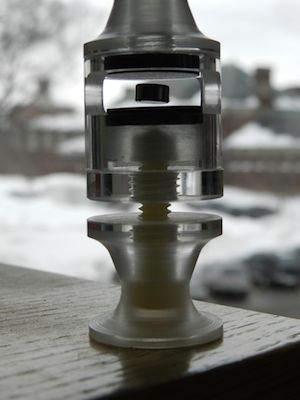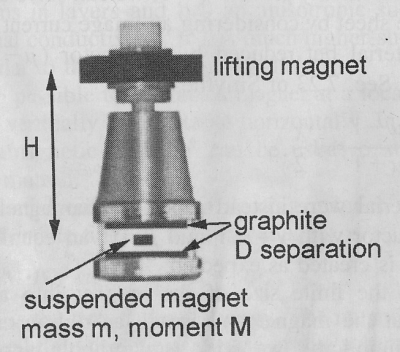What it shows:
Stable levitation of one magnet by another is usually prohibited by Earnshaw's Theorem, but the introduction of diamagnetic material at special locations can stabilize such levitation. The demonstration is a replica of an experiment described by M.D. Simon and A.K. Geim1 and is pictured in the photograph. The illustration is from their paper.


In our apparatus, the graphite separation D = 5.8 mm, and H = 40 mm.
How it works:
Ferro and paramagnetic substances align with the magnetic field and move toward field maxima. Since field maxima only occur at the sources of the field, levitation of paramagnets in free space is not possible. Thus, if one places a magnet in the field of a fixed lifter magnet where the magnetic force balances gravity and is stable radially, it will be unstable vertically — the slightest movement toward the lifting magnet increases the magnetic force on the suspended magnet and it will fly up to the lifting magnet. Similarly, the slightest movement away from the lifting magnet decreases the magnetic force and gravity immediately takes the upper hand.
Diamagnets are dynamic in the sense that their magnetization changes with the external field. They are repelled by magnetic fields and attracted to field minima. The suspended magnet induces magnetic fields in the diamagnetic material and experiences short-range repulsive forces from theses fields. The repulsive force is superimposed on the attractive force of the lifting magnet. If the two diamagnetic plates are closely spaced, this can result in a local potential minimum allowing for the possibility of levitation.
Bismuth and graphite are the elements with the strongest diamagnetism (χ ≈ -170×10-6). Graphite is the material of choice in this demo. The conditions for vertical and horizontal stability are calculated in reference 1 below.
Setting it up:
Set the acrylic holder on a non-magnetic table top. Adjust D and H to the values above and insert the small rare earth magnet with non-magnetic tweezers. You may have to tweak H a tiny bit to secure levitation. A video camera with close-up lens is required for audience viewing.
References:
1. M.D. Simon and A.K. Geim, "Diamagnetic levitation: Flying frogs and floating magnets (invited)," J Appl Phys 87(9), 6200-6204 (2000). A longer detailed paper was published a year later: M.D. Simon, L.O. Heflinger and A.K. Geim, "Diamagnetically stabilized magnet levitation," Am J Phys 69(6), 702-713 (2001).
2. C.A. Sawicki, "Small Inexpensive Diamagnetic Levitation Apparatus," TPT 39((9), p 556-558 ((2001).
3. C. Conery, L.F. Goodrich, and T.C. Stauffer, "More Diamagnetism Demonstrations," TPT 41(10), p 74-75 (2003).